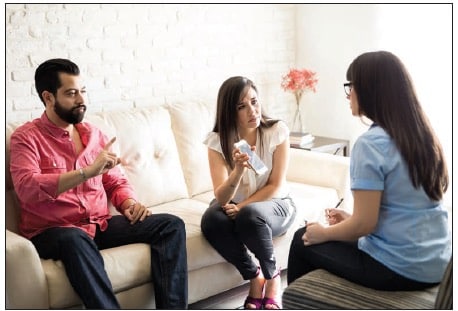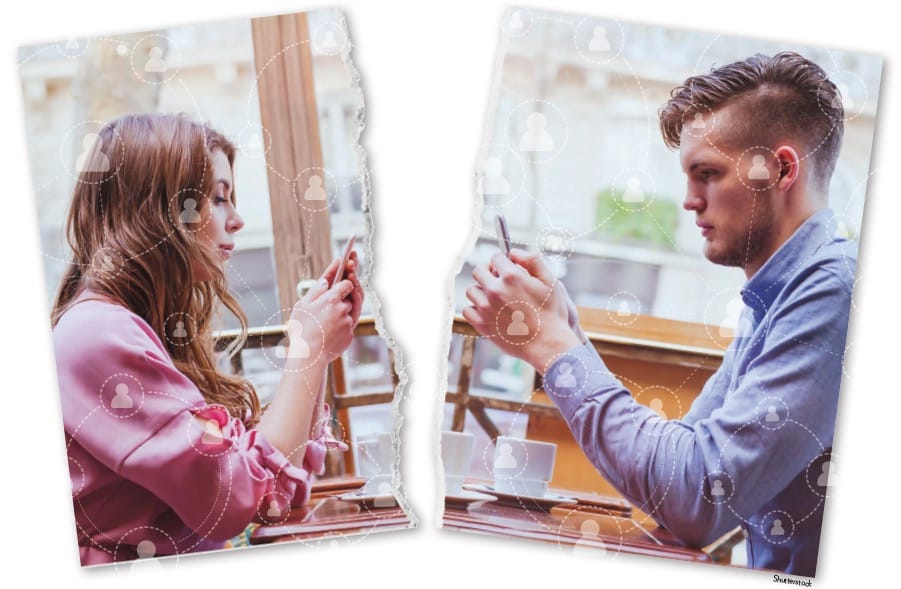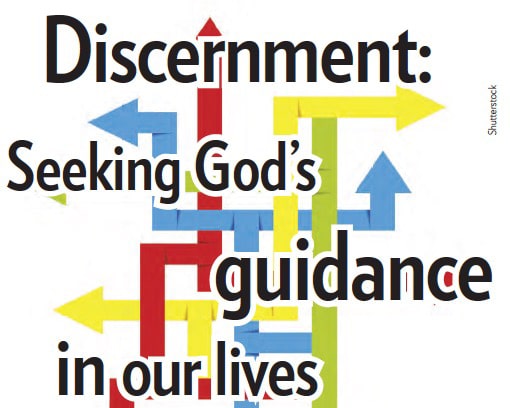Revolutions can happen in quiet ways. When Stephanie K. got her first smartphone at 14, it changed her “view on meaningful connections with people.” Instead of friends and acquaintances being found only in those she encountered face to face, they could come from Tumblr, Discord or any other social platforms with the straightforward mission of connecting strangers. One device allowed her simultaneously to extend her social circle, and also curate it.
One of those friends eventually became her boyfriend.
Stephanie, now a college freshman, told Our Sunday Visitor that as their interest in each other grew, they sometimes would be up until 4 a.m. texting back and forth. Living only a few hours apart, they try to visit each other on weekends. When they can’t, Stephanie said, they’ll have a Skype dinner together, in addition to the constant communication throughout the day.
But as beneficial as the world opened to her through the internet has been, there are limits — sharp ones — with consequences for human relationships in the 21st century.
“It’s human, but it’s not,” Stephanie acknowledged. For all the good that comes from communications freed from the limitations of distance, digital relationships miss the cues that are at the heart of the poetry of intimacy. The glances, reactions and idiosyncrasies of personality that reveal the person loved cannot appear fully, if at all, inside the artifice of a text message.
That distance between the person and their personality also creeps into relationships that do not depend on online contact, she said. She often sees anxiety about communicating with other people that gets soothed by interposing the phone.
“I’ve seen it happen where people were more interested in texting than hanging out in real life,” she said.
Relations speed up
 For Luke Carey, the widespread embrace of the internet by young people, especially in the 1990s, meant “no one knew that they were doing” when they started using it. Members of the generation that rapidly adopted the new technology were creating their own codes of online behavior as they went along. Carey, the director of young adult evangelization and discipleship for the Archdiocese of Cincinnati, told OSV that society redefined what a relationship is with their experience of the internet.
For Luke Carey, the widespread embrace of the internet by young people, especially in the 1990s, meant “no one knew that they were doing” when they started using it. Members of the generation that rapidly adopted the new technology were creating their own codes of online behavior as they went along. Carey, the director of young adult evangelization and discipleship for the Archdiocese of Cincinnati, told OSV that society redefined what a relationship is with their experience of the internet.
“Everything was face-to-face, and then that changed in the mid-’90s,” he said.
The internet, he said, also changed the speed of communication, which led to changes in how people connected.
 Dr. Lisa Petronis, a San Diego psychologist, told OSV that the rapid pace of online communication played into the desire for instant gratification. As access to people became faster, both the expectation of immediacy and impatience at delay have increased, a cycle to which people have adapted. But as everyone can attest, she said, “speed is usually not the most conducive characteristic in a relationship.” Patience is one of the defining virtues of love, she said, and relationships have suffered in a more fast-paced world.
Dr. Lisa Petronis, a San Diego psychologist, told OSV that the rapid pace of online communication played into the desire for instant gratification. As access to people became faster, both the expectation of immediacy and impatience at delay have increased, a cycle to which people have adapted. But as everyone can attest, she said, “speed is usually not the most conducive characteristic in a relationship.” Patience is one of the defining virtues of love, she said, and relationships have suffered in a more fast-paced world.
One of the other serious challenges to relationships, Carey said, is that when facing serious personal challenges, “we’ve conditioned ourselves to always find a way out.” Boredom, distress or any unwanted feeling can be soothed by the constant stream of information at hand.
Cultural changes
For Carey, the social changes brought by technology reflect a post-Christian culture. While there is nothing inherently objectionable in dating apps, Carey said, the immediate adoption of Tinder as a hook-up app reflects “a pornified culture, where everybody is just there to be used.”
In the anxiety over relationships, the rootlessness of contemporary American society and widespread pornography usage can be seen in a culture that no longer is inspired by God.
The bad fruits of the smartphone revolution can be seen in a culture that focuses on technological solutions to spiritual problems, he said. “We have a culture that says that mankind is going to save the day, and to put our faith in that.”
But the problems faced by a society increasingly raised on technology reveal the consequences of that approach. Solving those problems, he said, depends on doing more than changing habits around using a smartphone.
“If we don’t answer the questions of ‘Why do I exist? Is there a God?’ — if we don’t try to find the true, the good and the beautiful again, we’ll just end up where we were before.”
Swiping to excess
With more than 26 million matches a day, Tinder has become a household name for online dating. Users swipe right on a profile to indicate someone they are interested in talking to, and then can start up a conversation if the person they are interested in also swipes right. Although the app was billed as “a chance to meet people you wouldn’t normally meet” by Tinder social media director Alexa Mateen, it quickly became synonymous with hook-up culture.
But for many, as the app has matured, the pool of people looking for casual sex has been diluted by people using it to find healthy relationships, or just to make new friends.
Donna Provencher, a Catholic who has used Tinder, noted that one of the most significant drawbacks is the unspoken assumption that the app is about finding casual sex.
“You have to sift very carefully, because the balance is tipped toward people looking for that,” she said. But serious and thoughtful relationships can still come out of it.
Several months ago, Provencher flew from her home in New York to San Antonio for a job interview. Not knowing anyone in the city, her sister suggested she find someone on Tinder to show her around. Provencher agreed, and said she was “pretty upfront about wanting free tacos.”
Someone responded to her request, and the two of them got along well during the evening. While Provencher did not get the job, she kept in touch with her new friend, eventually beginning a long distance relationship with him, moving to Texas, and becoming engaged.
Apps like Tinder are popular because of the broad user base, she said, and the ability “to quickly sort the wheat from the chaff.” While it’s beneficial to be able to make quick judgments about suitability, Provencher acknowledged that Tinder “forces you to make conclusions very quickly” — more so than if someone tried to start up a conversation in a public space.
While Tinder and other dating apps allow people to chat before they meet, which can help mitigate first-date awkwardness, Provencher noted that online dating had become so commonly accepted that safety in meeting someone could be overlooked.
“At the end of the day, you’re still meeting a stranger off the internet,” she said.
For Provencher’s generation, online dating has gone from a niche to an unremarkable aspect of single life. Facing that change, she said, “we’re better off embracing it in a qualified sense than being a Luddite and rejecting it.”
Taking the human out of dating
But while many have had success on Tinder and similar dating apps, it often has deeply dehumanizing effects, said Angela Fernandes, a psychotherapist in Seattle.
“Tinder is a video game that everybody loses,” Fernandes said. The gamification of a human interaction has made it “the fast food of dating.” Not only is it heavily weighted toward hook-up culture, but it also enables more compulsive dating behavior by users, who fill up their evenings with different dates.
“I have clients who go on three to four Tinder dates in a day. That’s not something you could have done without this app,” she said.
That kind of high-frequency dating has Fernandes concerned about whether emotional connections are given time to occur at all.
“It’s an incredibly superficial world — we’re swiping right, swiping left, all based on a headshot,” she said.
Fernandes also is concerned about the effect on the well-being of women: “Deep down inside, they know they’re really being judged on their looks. You’re putting yourself out there to be assessed, and people are choosing you based on your photo. What does that do to your self-worth and self-esteem?”
According to Fernandes, the buffet-like experience of a dating app can subtly encourage low emotional investment in dates, because of the idea that there are always more matches waiting.
“You have a bloated sense of your dating pool, just because this person popped up on the screen, when really your chances are what they’ve always been,” she added.
| Facebook and the Utilitarian Ethos |
|---|
|
Recent months have seen more pointed questioning of the place Facebook occupies in contemporary society. Even as the social media giant has more than 2 billion monthly active users worldwide, its reputation has been damaged by successive scandals around user privacy and fake news. In March, Facebook discovered that 87 million Facebook users unknowingly gave their data to a researcher who worked for Cambridge Analytica, a political data firm hired by the Trump campaign. While Facebook maintained that the user data had been improperly obtained, it also noted that users consent to having their data shared with third parties when they create an account. The episode is the latest to call into question whether Facebook can be trusted with protecting the common good. For Jacob Groshek, an associate professor of Emerging Media Studies at Boston University, “the short answer is no.” Facebook’s responsibilities as a profit-driven company heavily motivated by advertising, he said, are “diametrically opposed” to the responsibility to protect users’ privacy and well-being.
“When people engage with free social media services,” Groshek said, “they’re opening themselves to a wide spectrum of risk.” A 2016 internal memo published on Buzzfeed from Facebook Vice President Andrew Bosworth also has caused a fresh round of criticism. In the memo, Bosworth seemed to indicate Facebook’s success was driven by growth, rather than the products it offers, and that harm to users through their platform was a cost of their business. For Bosworth, that Facebook could play a role in suicide or in terror attacks was an “ugly truth.” “We believe in connecting people so deeply that anything that allows us to connect more people more often is *de facto* good,” he wrote. Facebook executives later distanced themselves from the memo and claimed it did not represent their mission. For as much criticism as Facebook endures, Groshek noted that “it’s too difficult to expect one organization to monitor billions of users.” In the end, he said, “people need to be more aware of their usage of the site, and what they are entering into.”
|
Infidelity: Smartphone as a weapon
For marriages like Courtney’s, “the phone was a weapon.” Her husband organized his affair through his smartphone, and she discovered it through his phone. While they struggled to keep their marriage together, she often would bury herself in her phone “to escape,” leading to further recriminations in their already fraught relationship.
For Courtney, part of healing her marriage involved becoming more intentional about being present with the people around her, and setting boundaries on using the phone.

“There are incredible things that can be done with smartphones,” she said “and there are destructive things. It’s about: How do we use it for good?”
Inside relationships, the opportunities to be unfaithful have multiplied, while the difficulty in doing so has decreased, said Petronis. While marital troubles are not new, the barriers to finding an escort, someone to have an affair with or pornography are nearly nonexistent. Pornography in particular, she said, was a significant problem in marriages.
“Something that may have been a passing thought, which had a few barriers, you can now get with a click.” But even for people not intentionally seeking pornography, she said, its ubiquity provides a significant temptation.
Being mindful of those risks “requires more effort in this day and age.”
“Couples need to redouble their efforts, because it’s so easy to slip into those areas — men and women,” she said.
Pornography’s effects documented
Pornography is nearly inescapable in any stage of a relationship. A 2017 study titled “The Porn Gap” found that about 60 percent of women in casual and serious dating relationships reported never using pornography. Only 25 percent of men in casual and serious dating relationships could say the same.
Half of men in casual dating relationships reported looking at pornography weekly, or even more frequently, while about 20 percent of men who are engaged or married report frequent viewing of pornography. Despite nearly one-third of women believing that pornography was a form of marital infidelity, the study found a “consistent pattern” of women who rarely or never watch pornography in relationships with men who regularly view it.
 Brian Willoughby, a Brigham Young University professor who worked on the study, told OSV that viewing pornography does not have a monolithic effect, but depends on frequency of viewing and the type of pornography viewed.
Brian Willoughby, a Brigham Young University professor who worked on the study, told OSV that viewing pornography does not have a monolithic effect, but depends on frequency of viewing and the type of pornography viewed.
Inside relationships affected by pornography, he said, intimacy suffers, as the center of the relationship switches from a shared sexual act to an opportunity to enact a personal fantasy.
“There’s a shift from a focus on intimacy to expectations that are more selfish,” he said. Higher pornography usage is also linked to lower relationship satisfaction.
Willoughby said that academic study of pornography’s effects had tended to focus on how it affected well-being, but said there was research that linked increased porn consumption by people in dating relationships to a decreased value on the importance of marriage. He also said that there was some data linking pornography to more permissive views of infidelity.
A 2016 study found that for men and women who began to view pornography during their marriage, their chances of divorce doubled and tripled, respectively. The effect was even more pronounced in younger respondents.
Over-engaged, addicted, depressed
Petronis told OSV that people are “becoming overly engaged with technology.” She often sees disruption in personal relationships, which are drowned out by the allure of technology and its instant gratification.
“When a person is drawn into technology, it’s often at the expense of real social interactions, and then it seems to create an illusion of connection,” she said. That sense of connection often can mask how much their personal, as opposed to online, relationships are suffering.
And because more time is spent online, there are fewer opportunities to counter those effects.
“Individuals who are overly dependent on technology and social media are not out doing the things that would maintain a person’s health and well-being,” she said. Meeting up with friends in person, going outside, are all healthy, balancing activities that fail to occur.
| Rise of the Machines |
|---|
|
More than 39 million devices equipped with virtual assistants, such as Alexa or Google Home, have been sold in the United States. The habit of giving orders to a “perfectly obedient device” does not get compartmentalized, Hulse said, but could spill into other areas. “If we’re used to Alexa serving us, doing whatever we tell her, how will that translate to our interpersonal relationships?” But as the devices proliferate, they also bring more opportunities for companies to grow by building sophisticated user profiles. Recent patent filings by Amazon indicate more interest in monitoring daily conversations for what people like and dislike in order to target ads more efficiently.
|
Because of the addictive quality of technology, Petronis said it was important for people to pay close attention to how it can affect their well-being.
“With technology, a person is going to it even though it’s harming them. Not everyone who is using it is addicted, but there does seem to be a dependency that develops very easily.”
Petronis also pointed out that there was significant stress from feeling like one is always on demand.
“Something dings, and a person leaves what they’re doing to respond. There should be boundaries to accessibility,” she said. Those missed opportunities for social interactions — whether being distracted from paying attention to a child, or a family being in a room together but all on their phones — take their toll on family closeness.
Technoference in family life
Brandon McDaniel, a professor at Illinois State University, coined the term “technoference” to describe the intrusion of technology into time spent together.
While the behavior can be innocent, it nevertheless communicates that face-to-face relationships have a lower value than the technology when it comes to engaging a person’s attention. A 2014 study he worked on found that 65 percent of women in a relationship reported that technology interfered with the leisure time they spent with their partner, and 35 percent reported their partner would check their phone in the middle of a conversation.
Overall, the study found that couples who report more technoference have lower relationship satisfaction, more conflict over technology use and lower life satisfaction.

Technological interference also has a negative effect on parents and children. Around 35 percent of parents spend one-fifth of their time at the playground on the phone, and 65 percent of mothers reported that technology distractions intruded into playtime with their children.
A 2017 study by McDaniel showed that child behavioral problems such as anxiety, depression or hyperactivity are closely associated with parental distraction by technology. The long-term danger of those parental behaviors is that children normalize those interruptions and incorporate them into a view of how a healthy relationship works and what it means to express love.


 Although personal-assistant technology has become more common in homes, Sara Hulse told OSV that she still gets “taken aback” when she encounters the devices, such as Amazon’s Alexa. While they use human voices to respond to owners, she said, they also work as machines, which are designed to be controlled. A theology instructor at DeSales University in Pennsylvania, Hulse said that products such as Alexa are “a step toward blurring the distinction between the personal and the machine.”
Although personal-assistant technology has become more common in homes, Sara Hulse told OSV that she still gets “taken aback” when she encounters the devices, such as Amazon’s Alexa. While they use human voices to respond to owners, she said, they also work as machines, which are designed to be controlled. A theology instructor at DeSales University in Pennsylvania, Hulse said that products such as Alexa are “a step toward blurring the distinction between the personal and the machine.”




